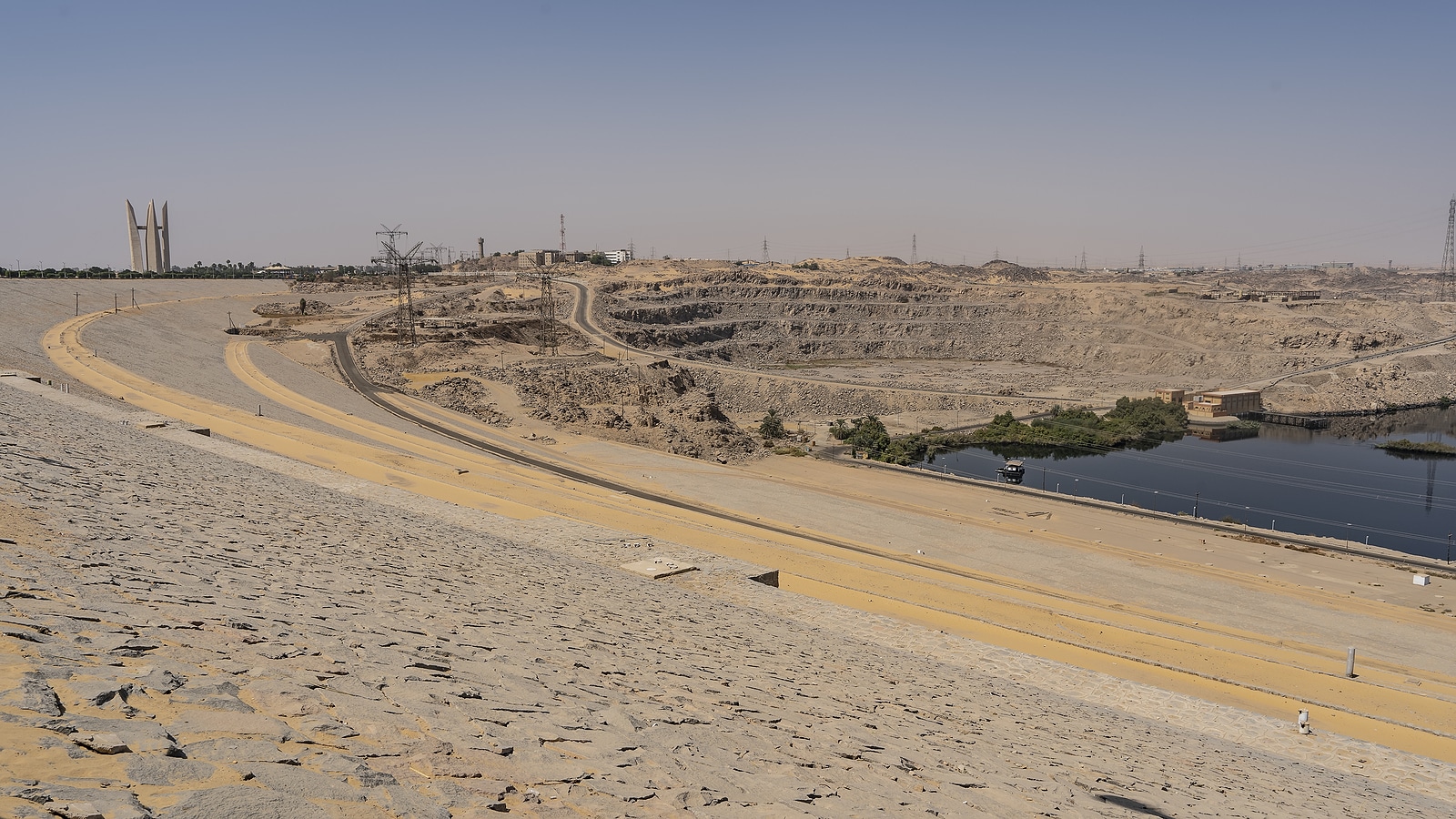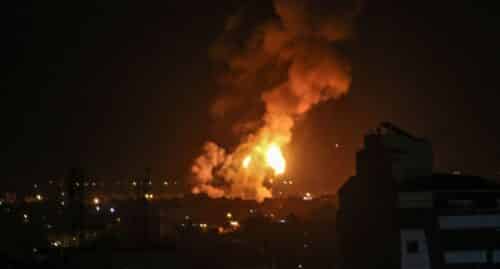Burgeoning tensions, far removed from its borders, may have serious security ramifications for Israel, much closer to home
…it would lead to political, economic and social instability. Millions of people would go hungry. There would be water shortages everywhere. It’s huge -,” Mohamed Nasr El Din Allam, formerly Egypt’s minister of water and irrigation, The National, April 23, 2012, on Ethiopia’s 2011 ambitious plans to dam the Blue Nile.
Ethiopia’s unilateral actions regarding the filling and operation of the dam constitute an existential threat to Egypt and a threat to its stability.–Egypt’s foreign ministry letter to the UN Security Council, October 2023.
As the fighting in Gaza rages and simmers perilously close to the boil in the North, and as Israel keeps a wary eye on the festering terror cells in the East, a new menace may be coalescing along another frontier: The long border between the western Negev and the Sinai Peninsula—running from the southern fringes of the Gaza Strip to the Red Sea port of Eilat.
However, unlike the other locations where the Arab-Israeli conflict flares, the reasons for this potential peril are not directly related to the Arabs’ perennial anti-Israel animosity that has fueled the decades-long conflict with the Jewish state. Rather its origins lie deep inside Africa and focus on the distribution of the waters of the continent’s mightiest river system among its second and third most populous nations—Ethiopia and Egypt respectively.
The roots of tension are twofold, one legal; the other engineering—the former entailing an almost one-hundred-year-old legal document; the other a massive hydroelectric enterprise in the deep gorges of the Ethiopian Highlands.
The history of the allocation of the Nile
The history of the conflict traces back to an agreement from the colonial era when the 1929 Anglo-Egyptian agreement was concluded between Egypt and Great Britain regarding the utilization of the waters of the Nile River—with Britain representing its upstream colonies in the Nile River Basin—Sudan, Uganda, Kenya and Tanganyika (today, Tanzania).
For decades, the waters of the Nile have been administered and allocated according to this 1929 treaty, which granted Egypt veto power over construction projects on the Nile River or any of its tributaries. With the end of colonial rule—prior to Cairo’s construction of the Aswan High Dam in 1960, which would flood extensive areas of Northern Sudan—this accord was followed, by a later 1959 Agreement—concluded bilaterally between Egypt and post-colonial Sudan.
This latter agreement effectively reinforced the provisions of the 1929 Anglo-Egyptian Treaty, making little allowance for the water needs of the other down-stream riparian states, including Ethiopia, which was not a signatory to either agreement and whose highlands supply more than 80 percent of the water that flows into the Nile River.
Inevitably, as populations—and water needs—increased, the hydrological realities began to change, challenging Egyptian hegemony over the river system and its utilization. However, the long-simmering conflict over the waters of the Nile between the upstream and downstream riparians, intensified in 2011 with Ethiopia’s decision to begin construction of a massive dam on the Blue Nile. Named the Great Ethiopian Renaissance Dam (GERD) it is Africa’s largest dam and the continent’s largest hydroelectric power plant—and among the largest in the world.

Ethiopian Electricity vs Egyptian Water
The potential power generation from the dam offers Ethiopia a chance to dramatically increase the supply of electricity in a country suffering from a dire power shortage. Although in recent years, the Ethiopian economy has been one of the world’s fastest-growing, it is still a country wracked by severe poverty, with which the GERD project offers a major opportunity to contend.
On the other hand, the Egyptians, afflicted by a grave lack of water, view with great trepidation the completion of a project that may potentially impede the flow of the river to their country, which is overwhelmingly dependent on the Nile for its water supply. Indeed, 85% of Egypt’s water comes from the Blue Nile, which originates in Ethiopia, and less than 7% from other indigenous resources.
The long-simmering conflict over the waters of the Nile, between the upstream and downstream riparians intensified in 2011 with Ethiopia’s decision to begin construction of the GERD. With fluctuating ups and downs, it flared again in February 2022 when Addis Ababa initiated the operation of the first of the dam’s 13 turbines, unilaterally initiating the production of electricity, without consultation or coordination with any of the other Nile nations. Tensions heightened again recently when Ethiopia reportedly completed the filling of the dam.
Water: The only matter that could take Egypt to war
Cairo has been frequently bellicose regarding the construction of GERD, which began to materialize towards the end of the four-decade-long incumbency of Hosni Mubarak in February 2011. Immediately after his overthrow, in late March the plans were made public, and several days later, the foundation stone was laid by the then Prime Minister of Ethiopia.
The Egyptians vigorously opposed the subsequent construction operations, engaging in at times belligerent diplomacy in an effort to dissuade the Ethiopians from their ambitious undertaking. In fact, Egyptian rejection of Ethiopia damming the Blue Nile system within its sovereign borders, pre-dates the GERD initiative.
Going back over four decades, Cairo has proclaimed that water could become a casus belli. Thus, in 1979, in the wake of peace accords with Israel, Egyptian President Anwar Sadat declared: “The only matter that could take Egypt to war again is water.”
A decade later, in 1988, then-Egyptian Foreign Minister Boutros Boutros-Ghali—later the UN Secretary-General—warned that the next war in the Middle East would be fought, not over politics, but over the waters of the Nile.
Thus, Stratfor cited a June 1, 2010 dispatch, according to which a “high-level Egyptian security/intel source, in regular direct contact with [President Hosni]Mubarak and [then-intelligence head Omar] Suleiman” said: ‘If it comes to a crisis [with Ethiopia], we will send a jet to bomb the dam and come back in one day, simple as that. Or we can send our special forces to block/sabotage the [planned]dam…’ “.

An archetypical “zero-sum game”.
Even though Mohamed Morsi, the leader of the short-lived Islamist regime (2012-13), was generally less menacing towards Addis Abba, he too—under pressure from his military, warned Ethiopia that “all options are open,” a reference to a possible airstrike, guerrilla sabotage, or destabilization of the Ethiopian government.
In 2021, current Egyptian president, Abdel Fattah el-Sisi, reiterated that “no one can take a drop from Egypt’s water, and if it happens there will be inconceivable instability in the region “
Yet, despite considerable bluster from Cairo, Addis Ababa has remained seemingly unperturbed.
Thus, as The Economist commented on the impasse: “…years of talks failed to produce a deal on how Ethiopia would fill and operate the dam. The African Union tried to mediate, as did America…Egypt wants Ethiopia to promise to release certain amounts of water to top up the Nile. But Ethiopia is loth to ‘owe’ water to downstream countries or to drain the reservoir so much that electric output suffers.”
Subsequent diplomatic efforts proved fruitless in resolving what is essentially an archetypical “zero-sum game”. After all, with a fixed (indeed decreasing) supply of water and increasing populations (and hence, demand for water) of the Nile nations, gains for upstream riparians (such as Ethiopia) must almost inevitably come at the expense of downstream ones (such as Egypt).
According to one expert, even today: “Egypt’s share of the Nile still falls [well]short of its annual water needs…Consistent increase in demand for water and proportionate decrease in its supply makes the future of Egypt even grimmer…”
Consequently, the pursuit of some consensual arrangement, adequately satisfactory to both sides, has proved consistently futile.
Sinai: Islamist insurgency
Almost at exactly the same time as the construction of the GERD began, significant events—albeit causally unrelated—began to emerge about 2000 km to the north, in the Sinai Peninsula that abuts Israel’s long southern border –and which precipitated increasingly grave security hazards for both Cairo and Jerusalem.
This was the beginning of a long and brutal Islamist insurgency against Egyptian security forces but did not spare luckless civilians from gruesome attacks. The insurgency began during the uprising in Egypt that led to the overthrow of Mubarak in 2011 and initially involved Bedouin tribesmen, some of whom harbored long-standing grievances against the central government in Cairo—but later attracted radical Jihadist elements from countries such as Syria, Iraq, and Libya. In 2014, one group, Ansar Bait al-Maqdis switched its allegiance from Al-Qaida to ISIS and renamed itself Sinai Province, making itself part of that pitiless Islamist organization.
The Egyptian military engaged with the insurgents—launching two operations under the Morsi regime in 2012 and 2013 to quash the violence but in 2013 following an abduction of Egyptian officers, violence surged again.
Interestingly, it was the during the insurgency that Abdul Fattah el-Sisi, currently President of Egypt, was appointed to the post of Defense Minister, by then-President Morsi, after dismissing Sisi’s predecessor, Muhammad Tantawi. Ironically, it was Sisi who later deposed Morsi, to succeed him as president.
Sinai: Diluting Demilitarization
After Morsi was ousted, violence increased. The Egyptian forces responded forcefully—including against civilians, with measures that involved, inter alia, demolition of houses and evacuation of residents to create anti-smuggling buffer zones. These harsh actions fanned the flames of resentment with the local population due—among other things—to government dereliction, and lack of suitable schools and health services. Numerous civilians were also abducted and butchered by the Jihadi insurgents.
The military action raged on for over a decade involving incidents of appalling violence. One of the goriest attacks, in November 2017, involved the slaughter of over 300 Sufi worshipers—including almost 30 children—in an El Arish Mosque in Northern Sinai.
At times the terror attacks erupted beyond the Sinai itself. For example, there were several lethal cross-border attacks against Israel that inflicted numerous casualties—including fatalities both on soldiers and civilians. Moreover, in 2015, a Russian airliner was brought down, reportedly by Sinai-based terror groups, resulting in over 220 deaths.
After years of strenuous and sustained military effort, in January 2023 President Sisi declared victory, proclaiming that “ we have defeated terrorism“, after a conflict of a decade and more, involving around 15 Islamist organizations that reportedly left almost 3,500 Egyptian security personnel dead and nearly 12,500 wounded, with up to 5,000 insurgents killed
Sinai: “Keeping the lid on”?
At this juncture, several points of strategic importance for Israel should be underscored. For Egypt to subdue the insurgency required employing considerable military resources over a protracted time period, beyond the level that Egypt was permitted to deploy in Sinai by the 1977 Camp David Agreements. Indeed, although the effective demilitarization of the Sinai was the corner-stone of the peace agreement between Egypt and Israel, given the challenges posed by the Jihadi insurgency, Israel reluctantly agreed in some cases, to the deployments of men and equipment over and above the stipulations of the agreement. In other cases, Israel expressed chagrin at Cairo’s unilateral breaches of the restrictions—even filing formal official complaints in this regard.
Currently, it appears that the Jihadi insurgents have been largely subdued, although some “post-victory” violence—involving fatalities among security forces in El Arish—has occurred.
So, the situation that prevails today in Sinai is one in which the authorities have managed to restore “the lid” on a simmering pot of latent violence, seething in a disgruntled civilian population—with a considerable military presence still required to maintain a semblance of law and order.
Indeed, in light of what some see as Cairo’s rather lethargic efforts to advance development and human rights in the peninsula, there is little guarantee that a future resurgence of the previous levels of violence will not re-assert itself in the future.
Accordingly, given the effort in terms of personnel and materiel called for to impose law and order in Sinai and prevent a renewed threat of its takeover by Jihadi warlords, one can only ponder how Cairo would react if faced with another situation, which gravely threatened vital national interests elsewhere, and required siphoning off resources currently deployed in Sinai.
The impact of GERD on Sinai
The troubling question that now arises is this: What would be the impact on Cairo’s ability to impose law and order in Sinai, if it perceives Ethiopia’s dam construction as creating an untenable situation regarding its ability to provide vital amounts of water to its population, and thus finds itself compelled to mobilize for coercive action to contend with the situation.
The threat to Egypt’s water in this regard is thrown into sharper relief by the significant role agriculture plays in Ethiopia’s economy, “accounting for 40 percent of the gross domestic product (GDP), 80 percent of exports, and an estimated 75 percent of the country’s workforce.“
Indeed, one would need to a giant leap of faith in Ethiopian altruism to entertain the possibility that Addis Ababa will refrain indefinitely from using the waters of the GERD for expanded irrigation, rather than merely for hydroelectric power generation as is currently foreseen.
So if the impasse with Ethiopia persists, and the grave water situation in Egypt continues to deteriorate, Cairo may well be forced to prioritize the wellbeing of the millions in the Nile delta over its endeavor to maintain its control over the remote Sinai—and draw off resources currently allocated to the continued pacification of the Sinai warlords.
This will inevitably result in giving greater rein to the anti-regime—and anti-Israel—radicals, who, in the past, have launched attacks against Israel and been heavily involved in smuggling arms into Hamas-controlled Gaza. These are likely to be exacerbated significantly if GERD-induced reductions in Egypt’s military capabilities take place.

The matter of military might
On paper, the Egyptian armed forces are far superior to those of Ethiopia. Indeed, in many—if not most—measures of military might, the Egyptians outstrip the Ethiopians by a factor of tenfold and more.
Thus, Cairo’s military budget is reportedly almost $10 billion ($9,400,000,00), while that of Addis Ababa is well under one billion dollars ($888,099,450). In terms of total aircraft, Egypt exceeds Ethiopia by over one thousand to under one hundred. In terms of fighters, the ratio is almost 250 to less than 25. Likewise, Cairo outstrips Addis Ababa in helicopters by almost 250 to barely 31—and 100 to 6 when it comes to attack helicopters. With regard to land forces, much the same holds true. While the Egyptian army has almost 5500 tanks, the Ethiopian military fields less than 700. As for artillery Egypt has around 3000 pieces (about half of them self-propelled); Ethiopia has barely 700—with just over 60 self-propelled.
Of course, as a landlocked nation, Ethiopia has no navy or other marine-borne forces of any significance, while the Egyptian navy boasts twenty large surface warships (13 frigates and 7 corvettes) as well as 8 submarines. This, together with 2 helo-carriers, provides Egypt with a clear advantage over Ethiopia in its ability to project military power.
The potential to project power
Accordingly, while in theory, the Egyptian armed forces are far superior to those of Ethiopia, in actual conflict, matters may be a little more complex than dry figures on fire power and projection capability. Significantly, in the only recorded military conflict between the two countries, the Egyptians were in fact severely defeated.
Add to this that Egypt would face several significant obstacles in attempting to either destroy or cripple the GERD; or intimidate the Ethiopians by military means regarding its operation
After all, Egypt will have to project military force—whether air force or special forces—over considerable distance. However, skeptics should note that in the past Egypt has proven itself both willing and capable of deploying military forces considerable distances from the homeland—albeit with less than overwhelming success in actual combat.
Thus in the early 1960s, Cairo dispatched up to 70,000 troops to (then) North Yemen–almost exactly the same distance away as the GERD—for ideo-political rather, than existential reasons—i.e. support for republican forces against royalists. By contrast, the issues involved in the dispute with Ethiopia are viewed as far more existential for the survival of the country. Interestingly enough, despite heavy losses in the 1962-67 Yemen engagements, by 2015, then-bitter memories seemed to have faded, with a military contingent in a now-united Yemen being deployed against the Shia Houthi rebels.
Significantly, there are reports that Cairo is engaged in an active search for military bases in various countries bordering Ethiopia—like Eritrea, South Sudan, Somaliland and Djibouti—largely due to GERD-related concerns
As the diplomatic process staggers on into its second decade
Accordingly, it would be foolhardy to discount the possibility of a military operation against Ethiopia to defend what it considers a vital national interest.
Arguably, one route for such an operation would be via Sudan, which has a more ambivalent attitude toward GERD, as it is likely to reap several benefits from the project—including enhanced flood control and increased electricity supplies. Moreover, it would be most likely to suffer severely from the consequences of an attack on the reservoir. Indeed, if Egypt is successful in causing large-scale damage to the dam wall, there is a real risk of severe flooding of extensive downstream areas particularly in southern Sudan—involving grave diplomatic repercussions for Cairo.
As the diplomatic process staggers on into its second decade, lurching from failure to impasse, Cairo faces a real possibility of escalating tensions with Addis Ababa which may, or may not, ignite into actual violence. In this regard, it should be recalled that around 95% of the population of the entire country is clustered around the Nile and its delta, while only about 1% reside in the Sinai Peninsula. Accordingly, the specter of the reduction of the Nile’s flow, particularly in time of drought, will compel Cairo to gear for such a “worst-case” eventuality—draining off resources from other areas of potential conflict.
For Israel, Sinai, sparsely populated and far-removed as it is from the main population centers along the Nile Valley, far west of the Suez Canal, which separates the peninsula from the rest of Egypt, is very much a case in point. After all, if the Egyptian government has to choose between allotting forces to confront Ethiopia to protect the flow to the Nile or to enforce law and order in the distant peninsula, there can be little doubt as to where its priorities would lie.
Accordingly, Israel must plan for a potential scenario, in which, along its long southern border and the vulnerable transport routes connecting the center of the country with the Red Sea port of Eilat—and of course, the Sinai-Gaza border—are subject to mounting fundamentalist threats from unfettered warlords in an increasingly lawless Sinai Peninsula.
Martin Sherman spent seven years in operational capacities in the Israeli defense establishment. He is the founder of the Israel Institute for Strategic Studies (IISS), a member of the Habithonistim-Israel Defense & Security Forum (IDSF) research team, and a participant in the Israel Victory Project.
https://www.globalfirepower.com/countries-comparison-detail.php?country1=egypt&country2=ethiopia




